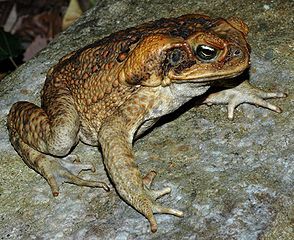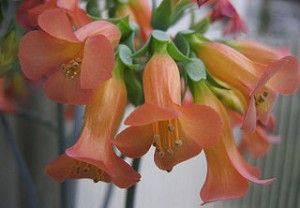How Animals Prepare for an Alien Invasion
Why can some—but only some—bluetongue skinks eat a toad that is poisonous to eat or even lick?
/https://tf-cmsv2-smithsonianmag-media.s3.amazonaws.com/filer/20120213101119bluetongue-skink.jpg)
American cane toads (Rhinella marina), native to Central and South America, are an invasive species in Australia. These toads contain a substance called “bufotoxin” that makes a lot of predators ill, sometimes fatally. (Warning: This is very poisonous stuff. Do not even lick a cane toad!)
Australian animals that eat this toad are typically poisoned by it, but one animal, the bluetongue skink (Tiliqua scincoides), appears to be able to eat the toad with few or no ill effects. Or, more exactly, some bluetongue skinks can eat the cane toads, depending on where they live.
Many animals and plants produce complex molecules (like bufotoxin) that have been shaped by natural selection to be toxic to predators. Some of our favorite spices, such as basil, chili peppers and other aromatic plants, owe their culinary properties to these molecular adaptations to herbivory. Only a few mammals produce molecular toxins, but many frogs and toads do.

If a weapon evolves in nature, there is a certain chance that a counter-weapon will also evolve. Many insects that feed on toxic plants have evolved the ability to sequester the poisonous molecules produced by those plants, rendering them harmless to the insect, and in some cases concentrating the undesirable substance in the insect’s own body to be used as a defense against insect-eating animals (usually other insects). Many mammals have enzymes in their digestive tract that detoxify plants that would otherwise be harmful. The evolution of toxicity and the evolution of anti-toxin strategies is considered an arms race between the eaten and the eaters.
So, it would be reasonable to suspect that the bluetongue skink has evolved a physiological mechanism to combat the bufotoxin produced by the cane toads. But it turns out that the explanation for the ability of some skinks to snack on the toxic toads is a little more complicated.
Another invasive species found in Ausralia is the ornamental “mother-of-millions” plant, a Bryophyllum from Madagascar. This plant produces a toxin that is chemically similar to bufotoxin. Why is it chemically similar to bufotoxin? This is probably a coincidence. If you have a large number of animals and plants producing toxins, sometimes there are going to be accidental similarities.

The mother-of-millions plant is invasive and found in the wild in certain areas of Australia, but it is not common everywhere. Bluetongue skinks that live where mother-of-millions is common appear to have adapted to eating them, and as such posses the ability to neutralize bufotoxin-like molecules. When these skinks encounter cane toads, they eat them without consequence. In fact, the skinks living in these area regularly eat both the mother-of-millions plants and the cane toads.
This research was was carried out by scientists at the Richard Shine Lab at the University of Sidney.
Price-Rees, Samantha J. Gregory P. Brown, Richard Shine, 2012. Interacting Impacts of Invasive Plants and Invasive Toads on Native Lizards. Natural History Editor: Craig W. Benkman. Published online Jan 25, 2012
/https://tf-cmsv2-smithsonianmag-media.s3.amazonaws.com/accounts/headshot/greg-laden-240.jpg)
/https://tf-cmsv2-smithsonianmag-media.s3.amazonaws.com/accounts/headshot/greg-laden-240.jpg)